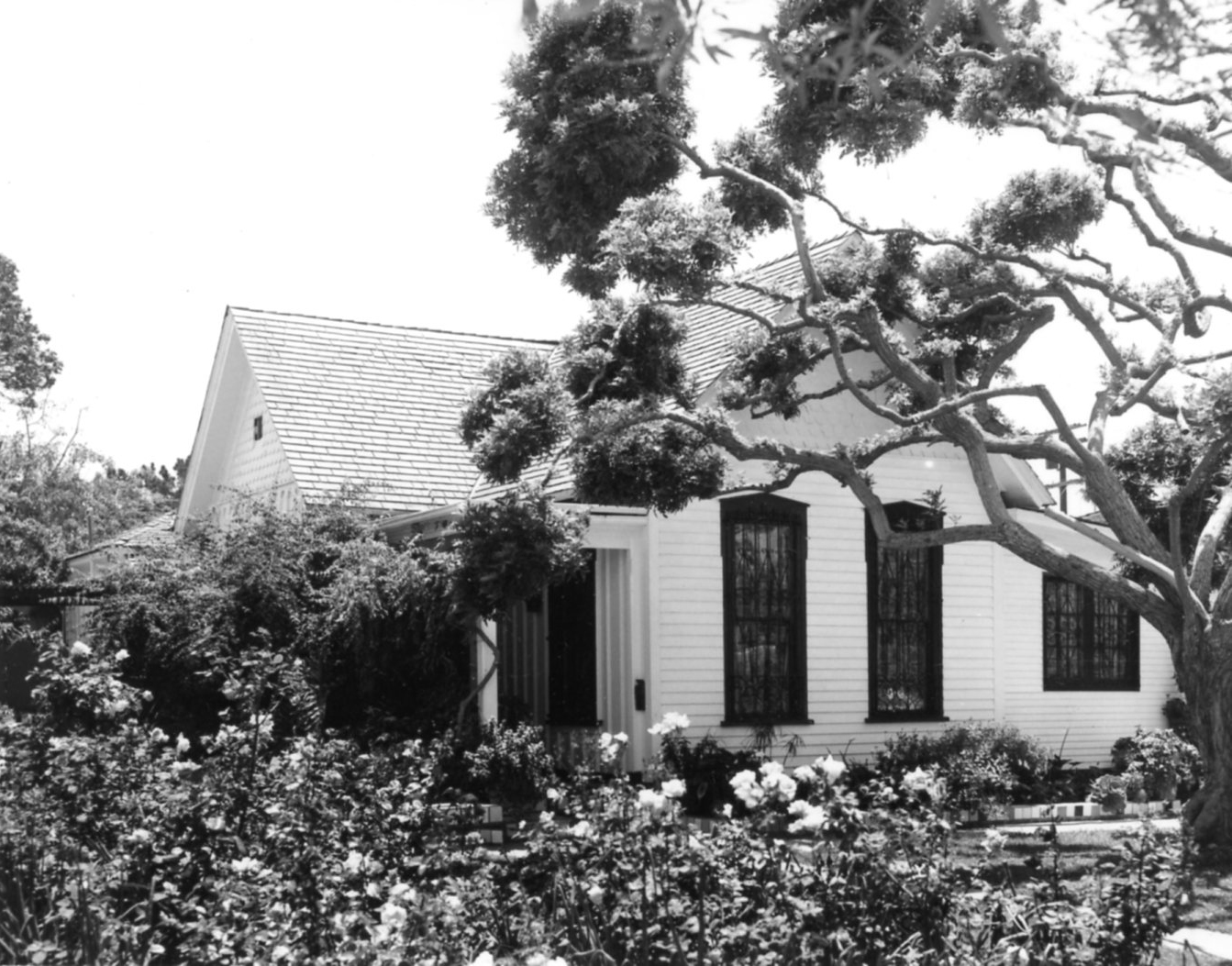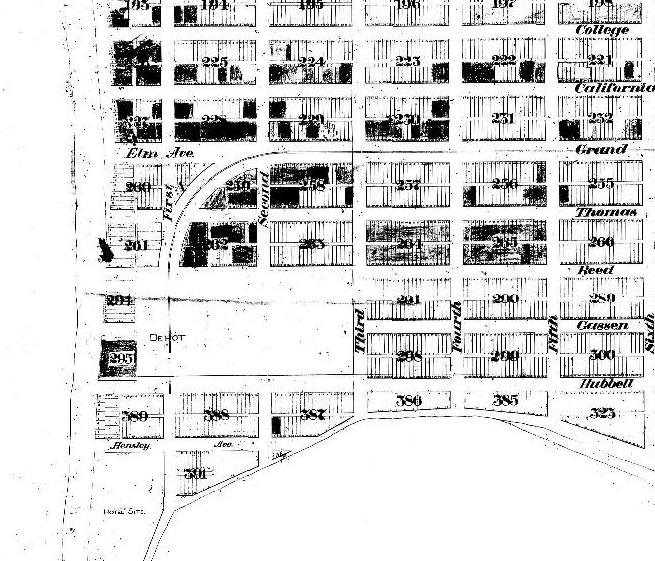
The April 2020 Pacific Beach Historical Society newsletter featured a letter describing the migration of the ‘Higbee clan’ from Hillsdale, Michigan, to Pacific Beach in 1906. George Higbee, Carrol Higbee and Lillian Higbee Ward and their families loaded all their worldly goods into a boxcar and embarked on a four-day train trip to San Diego, where they changed trains for the one-hour trip to Pacific Beach. The boxcar arrived in Pacific Beach the next day and the families went on to build homes on Thomas Avenue, some of which are still standing today. Anna Pittman, the author of the letter, was the daughter of Lillian and Edson Ward and would have been about six years old when she made the trip. Her letter noted that two other Higbees had preceded them to Pacific Beach; Herbert Higbee, a carpenter who had arrived about two years earlier and Elbert Rollin Higbee, who she said came to Pacific Beach around 1900. Anna and the ‘clan’ moved on after a few years, to El Cajon and Santee, but Herbert and E. R. Higbee remained residents of the southwestern corner of Pacific Beach for the rest of their lives.
Herbert Higbee was George’s son. In 1901 he had married Ruby May White in Hillsdale and the couple moved to Pacific Beach in 1905. In 1906 Herbert Higbee and Edson Ward, Anna’s father, bought lots in Block 263, the 900 block of Thomas Avenue, and built homes there. A couple of years later, in 1908, George Higbee also built next door to Herbert. Although Ward and George Higbee soon moved away, their houses are still standing, at 935-937 and 961-963 Thomas Avenue, as is a house Ward built and briefly lived in the year before, at 864 Thomas. Ironically, it is Herbert and Ruby Higbee’s house that is no longer there. Ruby’s 1957 obituary noted that she was the widow of Herbert Higbee, who built many of the early-day homes in the beach area but who had died in 1940; she had died in her home at 969 Thomas, where she had resided for more than half a century. Today 969 Thomas is the address of an apartment building.
E. R. Higbee had been the first of the Higbees in Pacific Beach, acquiring a pair of lots on the shore of False (Mission) Bay in 1896. This property, lots 33 and 34 of Block 387, is now on the grounds of the Catamaran Resort Hotel. It had once been owned by James Poiser, an Englishman who had spent time in Canada and Australia before arriving in the San Diego area. Poiser had purchased a plot of 40 acres in the north end of Pueblo Lot 1803 from Alonzo Horton in 1885 (Pueblo Lot 1803 included everything south and west of what would become the intersection of Pacific Beach Drive and Cass Street, including the peninsula that became Mission Beach). Pacific Beach rancher Wilbur Conover wrote in 1901 that Mr. Poiser owned and pastured this land to thousands of sheep and that his ranch house was down on the bay where there were then some very fine springs.
Conover added that Poiser, the sheep man, had then sold his holdings to the Pacific Beach Company for $50,000. This sale took place in September 1887, a month before the company drew up its subdivision map for Pacific Beach and three months before its opening sale of lots in the new subdivision. The deed described the parcel as 40 acres in the north end of Pueblo Lot 1803 excepting therefrom one acre ‘around the house now occupied by me to be taken off the end of any block that may be laid out to cover said ground’. The house, referenced in this deed months before lots were first offered for sale, was probably the first house ever built in what became Pacific Beach. The acre of land surrounding it was known thereafter as Poiser’s 1 Acre and it went on to pass through the hands of George Sikes and Susie Blackmer in 1894 and A. G. Strandberg in 1897 before being acquired by F. T. Scripps in 1899. Poiser’s 1 Acre was the first of many acres acquired by Scripps for his Braemar Manor estate and for the subdivisions that Scripps eventually developed in this corner of Pacific Beach.
The Pacific Beach Company’s subdivision map of October 1887 laid out a grid of city blocks divided by streets and avenues in the land it had acquired from Poiser and others. Block 387 was north of Hensley Avenue and east of Second Street, and adjacent to Poiser’s 1 Acre, which was ‘off the end’ of Block 391, south and west of Hensley and Second (Hensley Avenue was later closed by the city and absorbed into Scripps’ property; Second Street was renamed Bayard Street in 1900). In 1889 the Pacific Beach Company sold lots 33 and 34 of Block 387, the southwest corner of the block and closest to Poiser’s 1 Acre, to Poiser’s son Richard. In 1894 Richard Poiser sold these lots to George Sikes and it was Sikes who sold them to E. R. Higbee (or Higby) in 1896.
Elbert Rollin Higbee had been born in 1844, three years before his brother George. They lived in Chagrin Falls, Ohio, on the outskirts of Cleveland, where their father was a Free Will Baptist clergyman. According to the 1850 United States census they were neighbors of the Goodman family and their two daughters, Hattie and Celia. After serving in the civil war in the 125th Ohio Volunteer Infantry regiment he worked as a photographer in Chagrin Falls and in 1887 he and Hattie Goodman were married. They later moved to California and in March 1896 purchased the lots in Block 387 of Pacific Beach, where the San Diego Union reported he was building a three-room cottage. In 1896 their only neighbors would have been a row of three residences built for railway workers in Block 262, on Reed Avenue west of Bayard Street, adjacent to what was then the railway depot (one of these residences, at 854 Reed, survived until about 2021).
The 1900 United States census listed Elbert and Hattie Higbee as living in Pacific Beach in the same home as her sister Celia Goodman and a lodger, John Rockwood. Elbert Higbee was described as a painter and paper hanger and Rockwood as a miner. The 1900 census also listed a new neighbor, Lida Clarkson, who the Evening Tribune had described as one of the most celebrated women in the country, known far and wide as art editor of The Ladies’ Home Journal and with a world reputation as an artist. She had purchased one of the railway workers’ homes at the corner of Reed and Bayard in February 1900 and was having it remodeled. In July 1900 Lida Clarkson and John Rockwood were married and he moved out of the Higbees’ house and into her remodeled home.
In 1904 the Rockwoods built an apartment building, Rockwood Flats, next to their home on Bayard Street. The Rockwood Flats was the first apartment building in Pacific Beach and was noted for its dining room. The San Diego Union reported in May 1909 that the Monday Night 500 Club was royally entertained by the Braemar 500 Club at the Rockwood Flats on the Ocean Front and that the large dining room was beautifully decorated for the occasion. Among the hosts from the Braemar club were Mr. and Mrs. F. T. Scripps, Mr. and Mrs. J. M. Rockwood, Mrs. H. L. Higbee, Mrs. E. R. Higbee and Miss Celia Goodman.
Celia was still living with the Higbees in 1910, according to that year’s census, and the Rockwoods were still living at Bayard and Reed. The Higbees’ other neighbors in 1910 were the Scripps family, with four children, four servants and a chauffeur, at Braemar Manor directly across Bayard Street. Beginning with the purchase of Poiser’s 1 Acre at the end of 1899, Scripps had accumulated property in that corner of Pacific Beach north to Reed Avenue and east to Dawes (except for the two lots in Block 387 owned by the Higbees) and subdivided it as the Braemar subdivision in 1907. Also in 1907, Scripps, J. M. Rockwood and E. R. Higbee petitioned the city council for grading, sidewalking and curbing Bayard Street from Grand Avenue to Braemar Lane, the work to be done by these property owners under private contract. The curbs and sidewalks that still line Bayard date from this time.
E. R. Higbee died in 1914 and Hattie sold the property, lots 33 and 34 of Block 387, to his nephew Herbert Higbee in 1921. In 1925 Herbert sold it to F. T. Scripps, and with the area between Bayard and Dawes streets then completely under Scripps’ control it was re-subdivided as Braemar Extension in 1926. What had once been Block 387 became Block B of Braemar Extension, bayfront property intended as home sites for the Scripps’ children. To make room for a house for the oldest son, Thomas, the Higbees’ former home was moved to 953 Reed Avenue, where it still exists today (under a more recent second story). The Scripps estate on Mission Bay was itself replaced by the Catamaran resort in 1959 and its Building 700 now occupies the site where the Thomas Scripps and E. R. Higbee families once lived.



